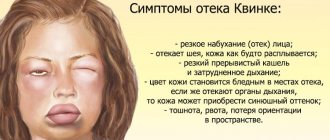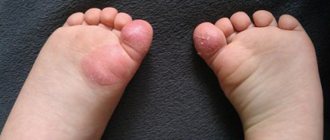Vertical or longitudinal grooves on the nails are found in many people.
If you carefully examine the plates at an angle, you will most likely find thin, barely noticeable lines running from the base of the nail to the free edge. This pattern is considered a variant of the norm. But it happens that the longitudinal grooves on the nails are deep and pronounced, differing in color from the plate. In this case, they indicate disorders, problems with nails or internal organs. Longitudinal grooves are formed on both the upper and lower extremities. Before trying to get rid of such a defect, it is important to find out the reasons that led to it.
Why do longitudinal grooves form on nails?
The reasons are associated with deterioration of blood circulation, metabolic processes in the extremities, slower cell renewal, injuries, and lack of nutrients.
Thus, the cause of longitudinal grooves on the fingernails is often a poorly executed manicure. For example, improper removal of the cuticle leads to damage to the plate in the matrix area. And then later, as the nail grows, its surface becomes not so smooth. The reason may also be due to constant nail extensions. When applying artificial coatings to a plate, irritating chemicals are used that destroy the top layer.
Other reasons why longitudinal grooves appear on the nails include:
- fungal infection or onychomycosis;
- psoriasis, lichen planus;
- unbalanced diet, lack of protein, nutrients (zinc, iron, vitamins A, E, group B);
- indigestion, incomplete absorption of nutrients;
- dryness, dehydration;
- stress, depression;
- diabetes;
- rheumatoid arthritis;
- diseases of the heart, blood vessels, nervous system;
- bad habits;
- contact with detergents and cleaning agents.
On the feet, especially longitudinal grooves on the nails are expressed on the big toe. This is due to the fact that its area is much larger. It experiences strain when walking, is more susceptible to injury, and is more likely to get fungal infections. Vertical stripes on the toenails occur when wearing tight shoes or excessive sweating.
A single vertical groove may be the initial symptom of onychorrhexis, or longitudinal splitting of the nail. Onychorrhexis is caused by peripheral vascular pathologies, Darier's disease, myxoid cysts and other disorders.
Longitudinal grooves do not always indicate serious problems; they are often a manifestation of age-related changes. After 55 years, due to decreased blood circulation, slower metabolic processes, and the rate of cell renewal, such stripes are found in most people. In older people, nails become dull, yellowish, and thicken.
Possible complications
Leukonychia often resolves without complications. If the cause is identified in time and treatment is started, the nail plate will soon recover, and the risk of recurrent streaks will decrease several times.
In advanced stages, the nail can become completely deformed. In this case, it is completely removed surgically. The new plate will grow in a few months, but during this period it is necessary to monitor the recovery process to ensure that the nail is growing correctly.
Healthy and well-groomed nails bring self-confidence to a person. Therefore, the appearance of longitudinal stripes on the surface of the nail plate primarily causes aesthetic discomfort.
Often a person does not pay attention to the development of irregularities, especially if the pathology disappears on its own. However, as a result of ignoring such a symptom, the patient may not only lose a nail, but also miss the onset of the development of a serious disease.
Article design: Mila Friedan
What do they look like?
Longitudinal grooves on the nails of the fingers or toes are vertical stripes or scratches slightly protruding above the surface of the plate. They also appear as depressions. Sometimes these are not stripes, but numerous, lined up dotted tubercles or depressions.
Depending on the cause, the photo of longitudinal grooves on the nails looks different.
One example:
Vertical grooves are often indistinguishable in color from the nail plate or are painted white, yellow, or brown. They can pass through the entire nail from the matrix zone to the free edge or be located at the top, bottom, or in the middle of the plate. They can be thin or thick, single or multiple, parallel to each other.
In addition to furrows, other symptoms will be present depending on the cause. For example, delamination, crumbling, brittleness, tarnishing, thickening. If the problem is a lack of vitamins, then in addition to the appearance of stripes, the color and structure of the plate changes. With a lack of iron, the nails become deformed and their shape begins to resemble a spoon. With a fungal infection, the affected areas lose transparency, change color, become yellow, tiny, and thickened. With onychorrhexis, longitudinal grooves cause cracks in the nails and, due to a violation of the integrity of the plate, increase the chances of becoming infected with a fungus.
It is important to pay attention to all accompanying symptoms and tell your doctor about them. This will help make the correct diagnosis faster.
The longitudinal relief strips themselves do not cause deformation of the plate and are almost invisible from afar. However, they lead to some difficulties with manicure and do not allow you to apply the polish evenly the first time.
When to see a doctor
Longitudinal stripes on nails do not always signal cosmetic problems, but may be one of the symptoms of damage to the human body. For this reason, you cannot self-medicate and wait until the irregularities disappear on their own.
In addition to the appearance of furrows, the following symptoms should alert the patient: change in color of the nail plate, poor health, hair loss, deterioration in concentration, irritability, headaches. First of all, the patient undergoes a consultation with a therapist, who prescribes general tests.
If the reason for the appearance of longitudinal stripes lies in diseases of the internal organs, then the patient is referred to see the following specialists:
- gastroenterologist;
- dermatologist;
- neurologist;
- infectious disease specialist;
- cardiologist;
- immunologist;
- endocrinologist
Solutions to the problem
Children often develop white dots and stripes on their nails. In this case, this is a manifestation of a lack of vitamins. It is enough to balance your diet and include more fresh vegetables and herbs in your diet or take a course of complex vitamins. It is worse if longitudinal or transverse convex stripes appear on the nail plates. This may signal serious pathologies. There are several accessible and easy-to-use methods that will neutralize external factors and relieve most symptoms of systemic diseases.
It involves carefully cleaning the surface of the nail with hardware in a beauty salon or independently using manicure tools. With deep stripes, the services of a specialist will be required; barely visible defects can easily be eliminated manually.
Paraffin therapy
The procedure is similar to a manicure, where the varnish is replaced with cosmetic paraffin. It is applied to a previously cleaned surface. The composition enriches nails with vitamins, eliminates bacterial flora, and promotes their healing.
Baths made from a combination of vegetable, cosmetic and essential oils are considered a good healing and strengthening remedy. The mixture is heated in a water bath to a comfortable temperature. The tip of the unhealthy finger is immersed in the mixture and held until it cools.
Massage
The diseased nail is pre-treated with a rich cosmetic cream or oil. The plate is then massaged with the tip of the thumb using light pressure. A feeling of warmth and redness indicates blood flow, after which the massage can be stopped.
Freshly squeezed lemon juice helps correct defects. It can be applied in drops to each sore nail or applied as a 10-minute lotion with the pulp. The juice must be absorbed, so the procedure is carried out before bedtime, interaction with water is avoided.
Iodine and soda
A strengthening and restorative effect is provided by baths with a solution of a few drops of iodine, 2 tsp. sea salt and soda dissolved in water. Baths are taken up to 2 times a day until the smooth texture of the nail is restored.
How to deal with them
First of all, you need to consult a doctor to find out what caused the appearance of longitudinal grooves on the nails. Adjusting your lifestyle is important - you should avoid stress, start eating right, getting enough sleep, etc.
Diet
Eliminate easily digestible carbohydrates from your menu (primarily baked goods and sweets), fast food, soda, alcohol, overly salty and spicy foods.
Be sure to stay hydrated and avoid dehydration. You need to drink about 1.5-2 liters of clean water per day.
What foods are recommended to include in the diet:
- leafy vegetables, beans, lentils (magnesium);
- red fruits - apples, pomegranates, currants (vitamins C, B, E, manganese);
- black radish (retinol, glycosides);
- rabbit meat, poultry (iron);
- dried apricots, nuts, sesame (calcium);
- fish oil (vitamin D);
- herring, mackerel, squid (selenium);
- oysters, wheat bran (zinc);
- oatmeal, brown rice (silica).
Be sure to read:
What to do if the skin on your newborn’s body is peeling
Special care
You definitely need to start taking care of your nails:
- rub a mixture of vitamins A and E into the cuticle and nail plate overnight;
- Apply a cotton pad soaked in apple cider vinegar to your nails . You can secure it on top with a plaster, put on cotton socks or gloves. Leave overnight. In the morning, wash the treated areas with laundry soap. The procedure should be carried out 2 times a week until the problem goes away. Vinegar gets rid of infection and strengthens the nail plate.
- It is useful to make baths with oils - almond, olive, jojoba, sea buckthorn or linseed (it needs to be heated until warm). Soak your feet or hands in the water for 10 minutes. Carry out a course of 10 procedures. This will improve the nail structure.
You can also apply vitamin creams and ointments to your nails, for example, Radevit.
Home treatments
You can eliminate unwanted manifestations on your nails at home. To do this, you need to know simple techniques that will help not only strengthen the nail plate, but also restore its structure.
Good remedies for healthy nails at home are:
- Compresses. Oils are ideal for this: vegetable or essential. Olive oil is considered the most beneficial oil for nails and skin. It perfectly moisturizes and nourishes. Oils can be mixed to create an individual cosmetic product that must be applied daily to damaged nails.
- Baths. There are a lot of recipes. However, the most useful is a hand bath with a solution of sea salt. Dilute 1 tbsp in warm boiled water. soda, 2 tbsp. sea salt and two drops of pharmaceutical iodine. Immerse your hands in the prepared solution for 15-20 minutes, then dry with a towel and apply nourishing cream to your nails. You can prepare herbal baths using infusions of pharmaceutical herbs: calendula, chamomile, oak bark, celandine.
- Massage. This procedure will help normalize blood circulation in the nail plate and improve the supply of nutrients. For massage, use nourishing nail cream or cosmetic oil. The product must be applied to the nail plate in a circular motion until a feeling of warmth from the massage appears.
- Lemon juice. Lemon is known to have whitening and restorative properties. You need to take the juice into a pipette and drop two drops onto each nail. Then you need to wait a while until the juice is completely absorbed into the plate.
Diagnostics
Since nails are an ideal indicator of health, any pathological changes should be addressed to a mycologist, dermatologist or podologist (a doctor specializing in foot diseases). Diagnosis is based on a comprehensive study of the presence of diseases in the patient. The following examination methods will help you get an overall picture:
- General urine and blood tests will detect the presence or absence of an inflammatory process.
- Ultrasound diagnostics of the liver and cardiovascular system will help to identify or exclude pathologies of these organs.
- A blood test to determine your vitamin and mineral balance will help you prescribe the right diet.
In addition to the initial examination, the following diagnostic procedures may be prescribed:
- UAC and BAC;
- general analysis of urine and feces;
- endoscopic examinations of the gastrointestinal tract;
- Ultrasound of internal organs;
- CT;
- MRI;
- ECG;
- immunological studies.
The exact diagnostic program will depend on the current clinical picture and the history collected during the initial examination.











